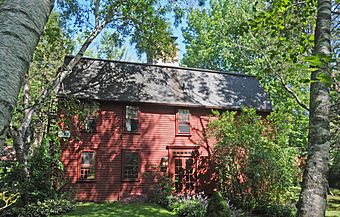Captain William Bull Tavern facts for kids
Quick facts for kids |
|
|
Captain William Bull Tavern
|
|
 |
|
| Location | 571 Torrington Rd., Litchfield, Connecticut |
|---|---|
| Area | 10 acres (4.0 ha) |
| Built | 1760 |
| Architectural style | Colonial, Federal, Colonial Revival |
| NRHP reference No. | 83001269 |
| Added to NRHP | June 30, 1983 |
The Captain William Bull Tavern is an old, important building in Litchfield, Connecticut. It's located at 571 Torrington Road. Today, it's part of the Tollgate Hill Inn and Restaurant. This tavern is special because it shows off amazing Colonial architecture. It also played a big part in saving old buildings in the area. It's even listed on the National Register of Historic Places, which means it's recognized as a very important historical site.
Contents
What the Tavern Looks Like
The Captain William Bull Tavern is in the northeast part of Litchfield. It sits on the north side of Torrington Road, which is also United States Route 202.
Building Features
This building is made of wood and has three stories. It features a special roof called a gambrel roof. This roof has two different slopes on each side. The tavern also has a large chimney in the middle. Its outside walls are covered with overlapping wooden boards called clapboards.
The front of the building has five sections, called bays. The main door is in the center. Above this door, there's a window with five small glass panes. This is called a transom window. There is also a decorative molding, or cornice, above the door. A second door was added on the west side when the building was moved in the 1920s.
Inside the Tavern
Inside, the tavern follows a common design for Colonial homes. There's a narrow entry area. A winding staircase leads up from this space. Rooms are located on both sides of the central chimney. Many original parts of the house are still there. Some new parts were added in the early 1900s. These additions were made to match the old Colonial style.
History of the Tavern
The story of the Captain William Bull Tavern began a long time ago. In 1756, Isaac and Eunice Bull bought a large piece of land in Litchfield. The house we see today might not have been built right away. We don't know who built it or owned it before 1790.
Captain William Bull's Time
During the 1790s, the house was owned by Captain William Bull. He was born in Hartford, Connecticut in 1748. When he passed away in 1799, his records showed he was a successful farmer. He owned two houses, one called an "old house" and another called a "mansion house." He also had many farm tools, animals, and valuable items like silver and brass candlesticks. He owned 275 acres of land.
The house stayed with the Bull family until 1827. After that, it was sold to the Buel family. Then, in 1843, the Candee family bought it. From 1867 to 1900, the Griswold family used it as a farm.
Saving the Tavern
After 1900, the house changed owners several times. By 1915, it was bought by the Vanderwaters. Sadly, the house was not being used. It was boarded up and falling apart. The Vanderwaters even thought about taking the house apart.
But the house was saved by Frederick W. Fuessenich! In 1923, he bought it. He had the house moved about two miles to where it stands today. It was placed right across from an old tollhouse. This tollhouse used to collect money from travelers until about 1860. Fuessenich named the building the "Tollgate Hill Tavern."
Frederick Fuessenich worked to restore the property. He made sure it could be used for modern life. But he also cared about keeping its history. He even moved an old schoolhouse and a barn from the same time period to the site. This helped create a historic setting around the tavern.



